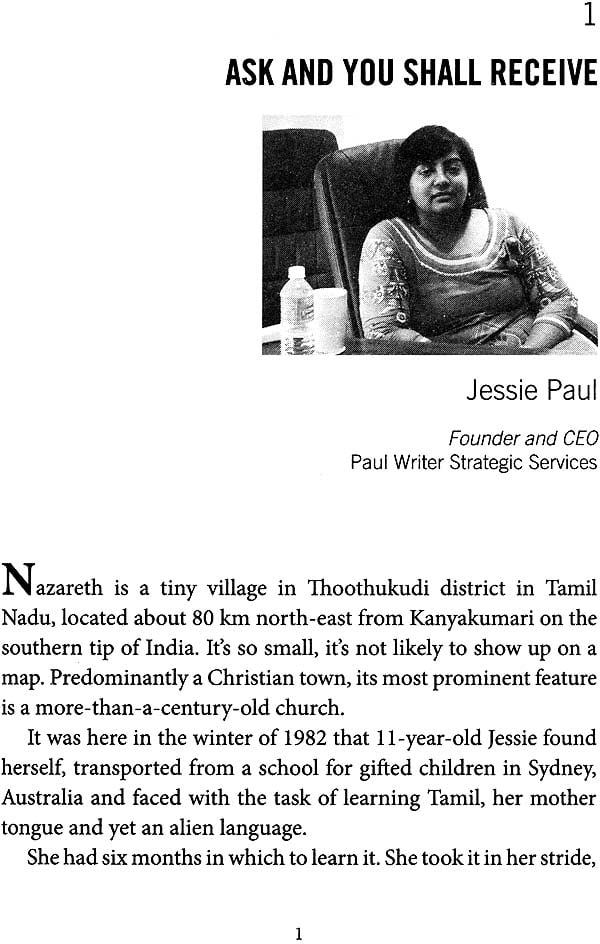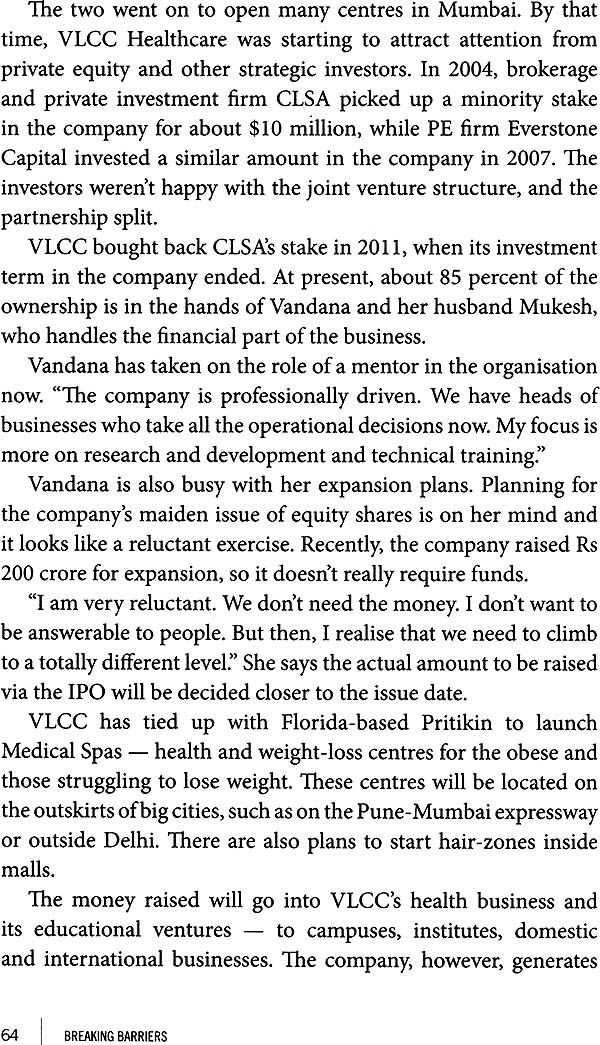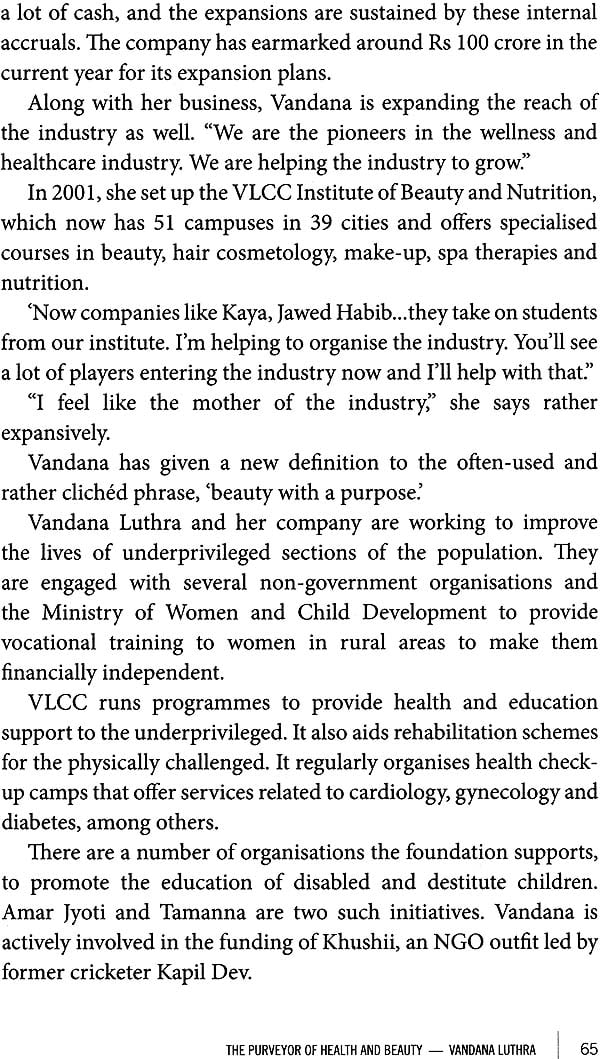
Breaking Barriers, Success Stories of India’s Leading Business women
Book Specification
| Item Code: | NAH561 |
| Author: | Janaki Krishnan |
| Publisher: | Jaico Publishing House |
| Language: | English |
| Edition: | 2013 |
| ISBN: | 9788184953954 |
| Pages: | 206 |
| Cover: | Paperback |
| Other Details | 8.5 inch x 5.5 inch |
| Weight | 280 gm |
Book Description
Breaking Barriers is a book chronicling the lives of some prominent Indian women entrepreneurs, who have followed their dreams and fulfilled their ambitions. They refused to succumb to the pressures and established norms that society insists on imposing on women. This book has been written to encourage girls and women (and indeed anyone who aspires to do anything out of the ordinary) to know that they are the sale arbiters of their lives. They have the Power.
Janaki Krishnan is a financial journalist who has worked across cities and across media, covering developments in the Indian economy and in the corporate sector right since liberalization. She is no stranger to boardroom battles, takeover attempts and regulatory probes, which is that keeps her adrenaline pumping. When not writing, she loves to travel, trek, swim, climb mountains and learn languages. Her idea of bliss is to be atop a mountain, feeling the wind in her face, a few dogs frolicking nearby, and with a book in her hand, to contemplate the mysteries of nature.
To write about successful women is always a pleasant experience, and when it is about successful Indian women, the pleasure is doubled. Women all over the world are successful in their own way, as with or without support, they happily juggle their roles of daughter, spouse, mother and caregiver, working both at home and outside. They bring up children, the future generation as it were, and are the essential bulwarks of family life, a role for which they are physiologically and sociologically equipped.
My definition of successful women, in the current context and for the purposes of this book, refers to a narrow spectrum of women who have made a name for themselves in the world of business and social enterprise, making their indelible mark in a milieu largely dominated by men.
Having been brought up in an environment and in a household where there was no differential treatment meted out on the basis of gender, my experience of any kind of bias against women, as such, is limited. I have also been extremely fortunate to have worked in organisations and with people in authority (read, men) who have given me more opportunities and recognition than I probably deserved. If there was any discrimination, it was mostly in my favour.
However, I realise that outside the cocoon of the protected bubble that I inhabit, many women do have to struggle against a lot of prejudices and discriminatory - often downright criminal - behaviour, right from the time they are born.
When I was approached to write this book, I jumped at the idea. In a country where child marriages are, lamentably, still practiced, honour killings are still prevalent, female fetuses are still aborted, where women are persecuted and divorced for giving birth to girls... women need all the encouragement and inspiration they can get, to get out of the mould that they are forced to conform to, often under the specious garb of upholding 'culture' and traditional 'values'.
The women who are chronicled in this book have been trailblazers and have risen to their current positions of eminence against all the odds stacked against them. And they have done it with dignity, without compromising on their integrity, keeping their hearts and minds fixed on their goals.
Being a woman, I understand very well the importance that role models play in our lives. During my adolescent years, I was inspired reading about the life of Marie Curie, the French-Polish Nobel Prize-winning scientist, who discovered radioactivity at the turn of the 20th century.
The story of Marie Curie is one of indomitable courage and the relentless pursuit of one's passion. As a student with scant monetary resources, she stayed in a cold, dark room in Paris and kept warm by covering herself with newspapers and sleeping under a table to keep out the cold. She could not afford lighting in her room and studied by the light of street lamps. She went on to become Professor of General Physics in the Faculty of Sciences at the Sorbonne, the first woman to hold this position.
While there is no age limit to being motivated and drawing inspiration, if it happens at a younger age, when our minds are still impressionable and more receptive to such emotions, it has a greater impact.
There is a peculiar dichotomy in the Indian social and cultural ethos. Ma Shakti is worshipped in the country as the universal emblem of female power, but girl children are unwanted. Goddess Lakshmi is revered as the fount of wealth, but girls are looked upon as a financial burden to the family. Saraswati is the goddess of learning, but when it comes to education, girls are given last priority. It looks like women work fine as divinities, but are not acceptable as humans.
Women make up roughly 50 percent of the population, but they have minimal voting rights in terms of representation in the socio-economic-political fabric, to use corporate terminology. Men write the rules; women follow the rules.
We know that today, women are joining the workforce more than they ever did, and economic independence has gone a long way towards emancipating women from the stranglehold of a patriarchal culture where women are often treated as the second sex. But evidence suggests that progress in this area is rather slow. A Hong Kong-based non-profit organisation, Community Business, carried out an interesting study in 2011, titled Gender Diversity Benchmark for Asia. The survey covered China, Hong Kong, India, Japan, Malaysia and Singapore. It interviewed women from a select sample of companies - all global corporations operating in these countries - and examined the representation of women at junior, middle and senior levels, in these companies.
The Community Business study pointed out that India was the worst performer when it came to representation at junior, middle and senior levels in the workforce. Among all the countries surveyed, India had the lowest percentage of women in the workforce.
The findings are not surprising. To begin with, in India, women make up just about 35 percent of the total workforce in the country, according to various surveys and studies conducted. That's a fairly low number. Even Malaysia, Indonesia and Philippines fare better.
Additionally, a lot of leakage happens in the transition from junior to middle levels. Compared to an average drop of 29 percent for Asia, in India, the drop was 48 percent.
Between the junior and the middle levels is when women - usually in their late 20s and early 30s - get married, have children and drop out of the career race to devote more time to their families, which accounts for the leakage. All the women whom I interviewed had supportive families - either their parents or their husbands - who allowed them to work through, without having to take a break, when their children were born.
So the scanty representation of women at senior level positions in the corporate sector is then explained by the leakage which takes place at the lower levels. The available pool of women at the middle level is already small and so the number of women who move to the senior positions is lower still.
| FOREWORD | vi | |
| INTRODUCTION | ix | |
| 1 | ASK AND YOU SHALL RECEIVE | 1 |
| Jessie Paul | ||
| 2 | THE SEEDS OF A REVOLUTION | 21 |
| Dr. Suman Sahai | ||
| 3 | THE PATH LESS TRODDEN | 39 |
| Ishita Swarup | ||
| 4 | THE PURVEYOR OF HEALTH AND BEAUTY | 55 |
| Vandana Luthra | ||
| 5 | A LAWYER BY OSMOSIS | 67 |
| Zia Mody | ||
| 6 | FILLING IN THE BLANKS | 81 |
| Dr. Uma Ganesh | ||
| 7 | I AM BORN FOR GREATER THINGS | 95 |
| Renuka Ramnath | ||
| 8 | A MISSION FOR EQUITY | 113 |
| Shaheen Mistri | ||
| 9 | AN IRON FIST IN A VElVET GLOVE | 131 |
| Anu Aga & Meher Pudumjee | ||
| 10 | THE ACCIDENTAL ENTREPRENEUR | 149 |
| Kiran Mazumdar-Shaw | ||
| 11 | I SHALL OVERCOME… | 165 |
| Kalpana Saroj | ||
| ACKNOWLEDGEMENTS | 187 |













